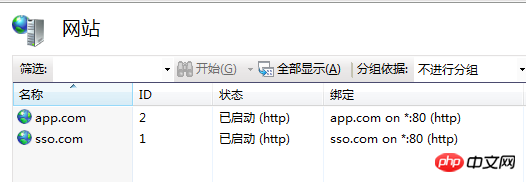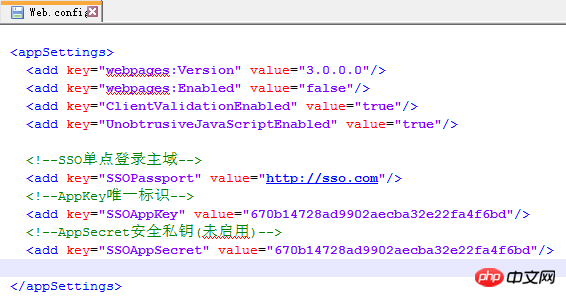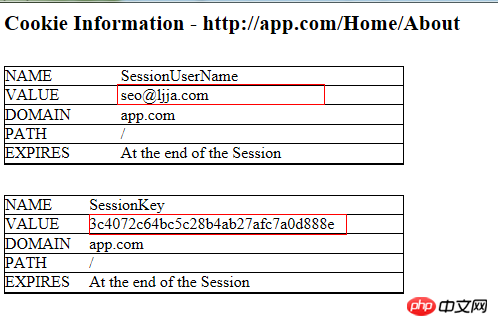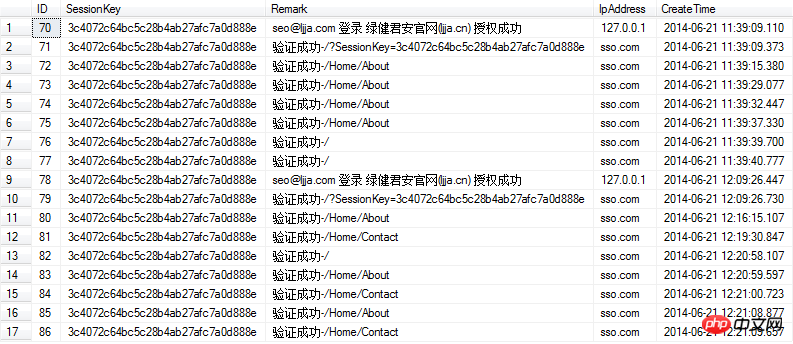詳解ASP.NET MVC SSO單一登入設計實例
- 零下一度原創
- 2017-07-03 17:28:553055瀏覽
本篇文章主要介紹了ASP.NET MVC SSO單點登入設計與實現,具有一定的參考價值,有興趣的可以了解一下。
實驗環境配置
HOST檔案配置如下:
127.0.0.1 app.com
127.0.0.1 sso.com
IIS設定如下:

應用程式集區採用.Net Framework 4.0

注意IIS綁定的域名,兩個完全不同域的域名。
app.com網站設定如下:

sso.com網站設定如下:
memcached快取:

資料庫設定:

資料庫採用EntityFramework 6.0. 0,首次運行會自動建立對應的資料庫和表格結構。
授權驗證流程示範:
在瀏覽器網址列中造訪:http://app.com,如果使用者尚未登陸網站會自動重定向至:http://sso.com/passport,同時透過QueryString傳送參數的方式將對應的AppKey應用程式識別傳遞過來,運行截圖如下:
URL位址:http://sso.com/passport ?appkey=670b14728ad9902aecba32e22fa4f6bd&username=



sessionkey=xxxxxx&remark=xxxxxx
傳回結果:true,false用戶端可以根據實際業務狀況,選擇提示使用者授權已遺失,需要重新獲得授權。預設自動重新導向至SSO登陸頁面,分別為:http://sso.com/passport?appkey=670b14728ad9902aecba32e22fa4f6bd&username=seo@ljja.cn 同時登陸頁面信箱位址文字方塊會自訂全使用者的登陸帳號,使用者只需輸入登陸密碼即可,授權成功後會話有效期限自動延長一年時間。SSO資料庫驗證日誌:
使用者授權驗證日誌:


#
/// <summary>
/// 公钥:AppKey
/// 私钥:AppSecret
/// 会话:SessionKey
/// </summary>
public class PassportController : Controller
{
private readonly IAppInfoService _appInfoService = new AppInfoService();
private readonly IAppUserService _appUserService = new AppUserService();
private readonly IUserAuthSessionService _authSessionService = new UserAuthSessionService();
private readonly IUserAuthOperateService _userAuthOperateService = new UserAuthOperateService();
private const string AppInfo = "AppInfo";
private const string SessionKey = "SessionKey";
private const string SessionUserName = "SessionUserName";
//默认登录界面
public ActionResult Index(string appKey = "", string username = "")
{
TempData[AppInfo] = _appInfoService.Get(appKey);
var viewModel = new PassportLoginRequest
{
AppKey = appKey,
UserName = username
};
return View(viewModel);
}
//授权登录
[HttpPost]
public ActionResult Index(PassportLoginRequest model)
{
//获取应用信息
var appInfo = _appInfoService.Get(model.AppKey);
if (appInfo == null)
{
//应用不存在
return View(model);
}
TempData[AppInfo] = appInfo;
if (ModelState.IsValid == false)
{
//实体验证失败
return View(model);
}
//过滤字段无效字符
model.Trim();
//获取用户信息
var userInfo = _appUserService.Get(model.UserName);
if (userInfo == null)
{
//用户不存在
return View(model);
}
if (userInfo.UserPwd != model.Password.ToMd5())
{
//密码不正确
return View(model);
}
//获取当前未到期的Session
var currentSession = _authSessionService.ExistsByValid(appInfo.AppKey, userInfo.UserName);
if (currentSession == null)
{
//构建Session
currentSession = new UserAuthSession
{
AppKey = appInfo.AppKey,
CreateTime = DateTime.Now,
InvalidTime = DateTime.Now.AddYears(1),
IpAddress = Request.UserHostAddress,
SessionKey = Guid.NewGuid().ToString().ToMd5(),
UserName = userInfo.UserName
};
//创建Session
_authSessionService.Create(currentSession);
}
else
{
//延长有效期,默认一年
_authSessionService.ExtendValid(currentSession.SessionKey);
}
//记录用户授权日志
_userAuthOperateService.Create(new UserAuthOperate
{
CreateTime = DateTime.Now,
IpAddress = Request.UserHostAddress,
Remark = string.Format("{0} 登录 {1} 授权成功", currentSession.UserName, appInfo.Title),
SessionKey = currentSession.SessionKey
}); 104
var redirectUrl = string.Format("{0}?SessionKey={1}&SessionUserName={2}",
appInfo.ReturnUrl,
currentSession.SessionKey,
userInfo.UserName);
//跳转默认回调页面
return Redirect(redirectUrl);
}
}
Memcached会话标识验证核心代码:
public class PassportController : ApiController
{
private readonly IUserAuthSessionService _authSessionService = new UserAuthSessionService();
private readonly IUserAuthOperateService _userAuthOperateService = new UserAuthOperateService();
public bool Get(string sessionKey = "", string remark = "")
{
if (_authSessionService.GetCache(sessionKey))
{
_userAuthOperateService.Create(new UserAuthOperate
{
CreateTime = DateTime.Now,
IpAddress = Request.RequestUri.Host,
Remark = string.Format("验证成功-{0}", remark),
SessionKey = sessionKey
});
return true;
}
_userAuthOperateService.Create(new UserAuthOperate
{
CreateTime = DateTime.Now,
IpAddress = Request.RequestUri.Host,
Remark = string.Format("验证失败-{0}", remark),
SessionKey = sessionKey
});
return false;
}
}Client授權驗證Filters Attribute
#
public class SSOAuthAttribute : ActionFilterAttribute
{
public const string SessionKey = "SessionKey";
public const string SessionUserName = "SessionUserName";
public override void OnActionExecuting(ActionExecutingContext filterContext)
{
var cookieSessionkey = "";
var cookieSessionUserName = "";
//SessionKey by QueryString
if (filterContext.HttpContext.Request.QueryString[SessionKey] != null)
{
cookieSessionkey = filterContext.HttpContext.Request.QueryString[SessionKey];
filterContext.HttpContext.Response.Cookies.Add(new HttpCookie(SessionKey, cookieSessionkey));
}
//SessionUserName by QueryString
if (filterContext.HttpContext.Request.QueryString[SessionUserName] != null)
{
cookieSessionUserName = filterContext.HttpContext.Request.QueryString[SessionUserName];
filterContext.HttpContext.Response.Cookies.Add(new HttpCookie(SessionUserName, cookieSessionUserName));
}
//从Cookie读取SessionKey
if (filterContext.HttpContext.Request.Cookies[SessionKey] != null)
{
cookieSessionkey = filterContext.HttpContext.Request.Cookies[SessionKey].Value;
}
//从Cookie读取SessionUserName
if (filterContext.HttpContext.Request.Cookies[SessionUserName] != null)
{
cookieSessionUserName = filterContext.HttpContext.Request.Cookies[SessionUserName].Value;
}
if (string.IsNullOrEmpty(cookieSessionkey) || string.IsNullOrEmpty(cookieSessionUserName))
{
//直接登录
filterContext.Result = SsoLoginResult(cookieSessionUserName);
}
else
{
//验证
if (CheckLogin(cookieSessionkey, filterContext.HttpContext.Request.RawUrl) == false)
{
//会话丢失,跳转到登录页面
filterContext.Result = SsoLoginResult(cookieSessionUserName);
}
}
base.OnActionExecuting(filterContext);
}
public static bool CheckLogin(string sessionKey, string remark = "")
{
var httpClient = new HttpClient
{
BaseAddress = new Uri(ConfigurationManager.AppSettings["SSOPassport"])
};
var requestUri = string.Format("api/Passport?sessionKey={0}&remark={1}", sessionKey, remark);
try
{
var resp = httpClient.GetAsync(requestUri).Result;
resp.EnsureSuccessStatusCode();
return resp.Content.ReadAsAsync<bool>().Result;
}
catch (Exception ex)
{
throw ex;
}
}
private static ActionResult SsoLoginResult(string username)
{
return new RedirectResult(string.Format("{0}/passport?appkey={1}&username={2}",
ConfigurationManager.AppSettings["SSOPassport"],
ConfigurationManager.AppSettings["SSOAppKey"],
username));
}
}範例SSO驗證特性使用方法:
#
[SSOAuth]
public class HomeController : Controller
{
public ActionResult Index()
{
return View();
}
public ActionResult About()
{
ViewBag.Message = "Your application description page.";
return View();
}
public ActionResult Contact()
{
ViewBag.Message = "Your contact page.";
return View();
}
}
總結:
從草稿範例程式碼中可以看到程式碼效能上還有很多優化的地方,還有SSO應用授權登陸頁面的使用者帳號不存在、密碼錯誤等一系列的提示訊息等。在業務程式碼運行基本正確的後期,可以考慮往更多的安全性層面優化,例如啟用AppSecret私鑰簽章驗證,IP範圍驗證,固定會話請求攻擊、SSO授權登陸介面的驗證碼 、會話快取自動重建、SSo伺服器、快取的水平擴展等。
以上是詳解ASP.NET MVC SSO單一登入設計實例的詳細內容。更多資訊請關注PHP中文網其他相關文章!
陳述:
本文內容由網友自願投稿,版權歸原作者所有。本站不承擔相應的法律責任。如發現涉嫌抄襲或侵權的內容,請聯絡admin@php.cn

